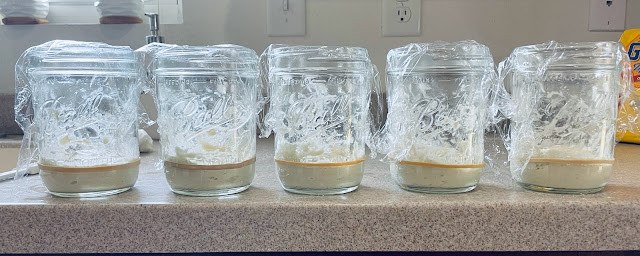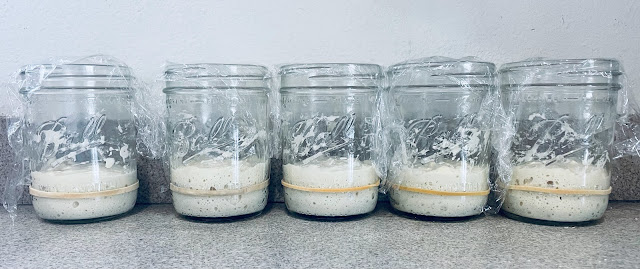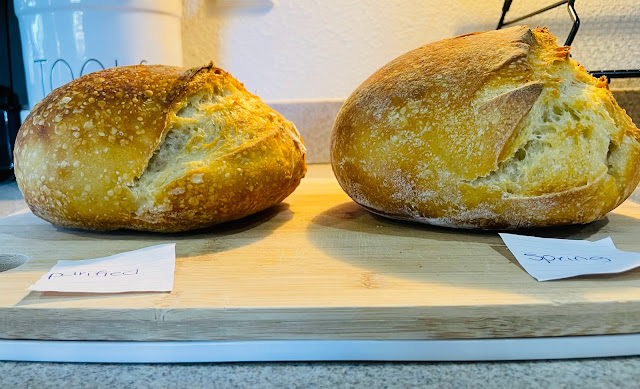When I started my sourdough journey I used all purpose flour and reverse osmosis (RO) water to create my starter. I had always read to use bottled water because the chlorine and other chemicals in tap water can be harmful to your starter so I mistakenly thought RO would be perfect because it definitely doesn't have chlorine in it...
Fast forward a couple years, I really dove into researching sourdough bread to better understand and learn more. I bought my first book and low and behold I read NOT to use RO water! It didn't explain why so I began to google, read blogs and forums in Facebook groups. The consensus I was seeing is that RO water is stripped of chemicals and minerals - minerals which are needed and essential for your starters health and growth (or is it???). I read that the best water to use was filtered tap or spring water.
I decided to conduct an experiment to see how my starter would react to different waters. In the middle of this experiment I realized that I probably would have gotten better data if I had actually started a brand new starter with each water instead of using my healthy thriving starter but maybe I'll do that another day (probably not).
In this experiment I used bottled purified (Aquafina), bottled spring, hard water, soft water and RO. I used 1 tablespoon of my existing starter and fed with 2 tablespoons of gold unbleached bread flour and 1 tablespoon of the labeled water.
Day 1 after the first feeding I noted that all had about doubled. The hard and soft water looked happiest to me with the most growth and larger bubbles. RO looked the least happy to me with much smaller bubbles.Later that evening I noticed that while RO had the smallest bubbles it rose the highest. The purified water rose the least and the 3 in between looked pretty happy to me.
I discarded half of the starter from the night before and fed each jar 1/4 cup flour with 2 tablespoons of water.
This time Rose bubbles were larger and it looks great compared to the others. The one I thought looked a bit behind was bottled purified.
By peak on day 2 I was really loving the way spring water looked. Even though it rose just as high I felt like the bubbles in purified were in last place.
By 10pm on day 2 RO had risen above the rest! I'm still loving the looks of spring and not impressed with purified.
On day 3 I discarded half again and fed with 1/4 cup flour and 2 tablespoons water. RO took off like it was a race and purified is still looking a bit lackluster to me.
A few hours into day 3 and RO had risen the most again. Purified rose the least and had smaller bubbles. I thought the other 3 all looked great!
When the starters reached peak I used them to prepare dough because why not continue on and check the way baking and crumb react? I am using my mini basic sourdough recipe of 2 cups bread flour, 3/4 cup water, 2 tablespoons starter and 1 teaspoon salt.
It could be pure coincidence but while conducting my stretch and folds I noticed that it took purified longer to get to that smooth elastic state. It eventually got there but seemed to be a tad bit behind the rest.
I do not have an answer on what water is best to use but I do have some notes, observations and questions after conducting this experiment.
Purified water is filtered water to remove impurities like bacteria, viruses, chemical pollutants and minerals, even beneficial minerals. Because of the fact that it seemed to do the worst in this experiment I will likely never use this type of water.
Spring water is rich in magnesium, potassium, calcium, sodium and other beneficial minerals, it was also mentioned being the healthiest water you could possibly drink. It performed well during this experiment and I am contemplating switching to using spring water in my starter and all future bakes.
Hard water contains high levels of dissolved minerals, mostly in calcium and magnesium. It is not considered dangerous for consumption but I read it was not recommended to use in starter. On day 1 I thought hard water was going to come out the winner in this experiment because the bubbles were the largest and it really seemed happy.
Soft water is the removal of calcium, magnesium and other metals. It tends to be higher in sodium and is listed as not safe to drink or use in starter. I likely will not use this type of water in my starter but it did seem to do just fine.
RO water has undergone a process to remove all chemicals and minerals in the water and was not recommended for use in starter.
As you can see the water not recommended for use in starters still performed just fine. I do not know the levels of chlorine in the tap waters or what is considered a dangerous amount of chlorine in your starter. I have read of people all around the world using their tap water and their starter and breads turning out just fine. I also read that filtered tap was better to use but saw that it performed the worst when compared to the others. Based on the results I saw with my own experiment I will likely use RO and/or spring water in the future. The only reason I am hesitant to use the hard and soft water is because I do not know what chemicals are present and do not want to risk the chance of harming my starter over long term use.
I put the dough in proofing containers to double at 2:30pm. This photo was taken at 9pm - 6.5 hours later. The spring, hard and soft water all doubled but the purified and RO were lagging behind. At this point I went ahead and shaped them and put them in their proofing baskets in the fridge on a Wednesday night.
The loaves were baked on Friday morning at 450º for 30 minutes with lid on and 10 additional minutes with the lid off.
Since purified and spring had the most noticeable differences in rising I baked them first to compare. The rise I got out of spring vs purified was much better however remember how spring doubled during proofing and purified did not so I suspect that had something to do with it as well.
Up close shots of crum. We did a taste test once cut and oddly enough the soft was our favorite for texture and flavor of bread. I am curious if this has to do with the higher sodium content in soft water.
We liked the texture of the purified but the flavor was subtle.
We did not care for the texture of spring, it wasn't as soft as purified and it was a bit dry however we did like how the sourness flavor was stronger.
Hard was very similar to purified in that it had a nice soft texture but subtle flavor.
RO was the least favorite with an ok texture but little to no flavor.
Overall what I learned is that any water can really be used to make a decent loaf. Your water should contain beneficial minerals and not contain too much chlorine. Tap water should do just fine and if you think it's heavily chlorinated, just leave it out on the counter overnight. If tap water doesn't work well for you then bottled spring water is another great option. Use whatever works best for YOU!



























Comments
Post a Comment